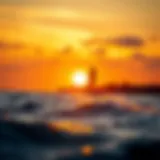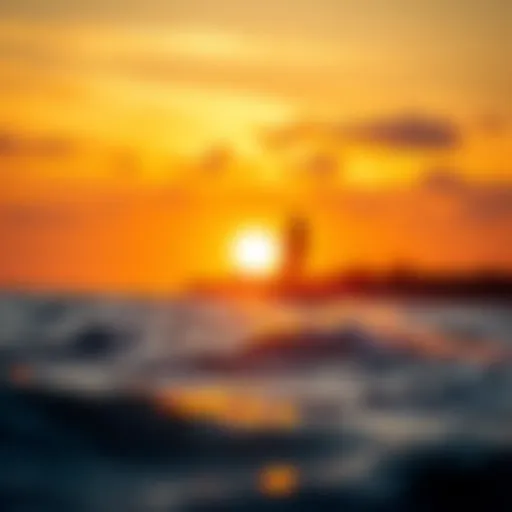Discovering Kenya's Stunning Beaches: A Complete Guide
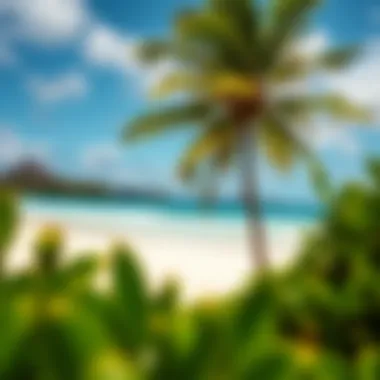

Intro
Kenya's coastline stretches over 500 kilometers along the Indian Ocean, offering a tapestry of breathtaking beaches that cater to every type of visitor. From the lively shores of Diani to the quieter sands of Watamu, this area presents more than just picturesque views—it holds a rich blend of culture, adventure, and nature that beckons both sunbathers and thrill-seekers alike. This guide takes a close look at these coastal wonders, highlighting what makes each beach unique and the experiences they offer.
Particularly for those interested in kiteboarding, the Kenyan coast is a renowned destination, providing ideal wind conditions and striking settings. Thus, in addition to exploring various beach locales, we will delve into techniques that kiteboarders of all levels can utilize to maximize their experience on the water.
As we uncover specific beaches, we'll touch on accessibility, local community engagement, and the environmental significance of this coastal region. Factors like tides and weather conditions will be discussed as they play a crucial role in planning your visit. Emphasis will be given to how these elements combine for a holistic experience that extends beyond mere relaxation.
The cultural aspects of coastal life will not be left behind either; from the mouthwatering local cuisine to the vibrant community festivals, there's a whole lot to take in for anyone setting foot on these sandy shores. This guide aims to serve as a well-rounded resource for both seasoned travelers and curious first-timers.
With that, let us navigate the tides of adventure and exploration that Kenya's beaches have to offer.
Intro to Kenya's Beaches
Kenya's coastline extends about 536 kilometers along the Indian Ocean, presenting a captivating mix of natural beauty, rich cultural heritage, and diverse recreational activities. Understanding the beaches of Kenya is not just about identifying locations; it's about appreciating the intricate web of ecological, cultural, and economic factors that shape these vibrant coastal destinations. From the bustling shores of Diani to the serene stretches of Lamu Island, each beach tells a story that resonates with both local traditions and modern influences.
Geographical Overview
Kenya's beaches can be largely divided into several unique sections, each varying in topography and marine life. The southern coast, which includes well-known spots like Diani Beach, boasts white sands and fringing coral reefs. Moving north to Malindi and Watamu, the coastline becomes characterized by rocky outcrops and hidden coves.
The geography doesn't just enchant the eye; it also plays a significant role in shaping the local climate and ecosystem. For instance, the trade winds whipping through these coasts influence the best seasons for kiteboarding, making certain areas prime for enthusiasts during specific months. Furthermore, the beaches are framed by mangrove forests and coral reefs, contributing to rich marine biodiversity that supports both fishing and eco-tourism.
The layout of the coastline also facilitates various activities, whether it’s peaceful sunbathing, adventurous water sports, or wildlife observation.
Cultural Significance
Diving into the cultural aspect reveals a tapestry woven from the legacies of ancient Swahili civilizations, colonial influences, and contemporary artistic expressions. The beaches of Kenya are not merely physical spaces; they serve as venues for cultural festivals, showcasing local crafts, culinary delights, and traditional music. For instance, Lamu Island celebrates its UNESCO World Heritage status with vibrant cultural festivities that attract visitors worldwide.
Moreover, each beach area has its own local customs and traditions, deeply rooted in the community's history. The fishermen of Malindi, for example, still practice techniques passed down through generations, while coastal towns like Watamu feature marketplaces brimming with locally sourced produce and handicrafts.
Engagement in these cultural experiences allows visitors, especially kiteboarders and water sports enthusiasts, to connect more deeply with the local environment and its people. Learning about the stories behind these beaches enhances visitors’ appreciation for both the land and the ocean, instilling a sense of responsibility toward preserving these wonders for future generations.
"The coast of Kenya is a reflection of the soul of its people and the agency of nature, a reminder that every wave carries with it tales of resilience, culture, and harmony."
Top Beach Destinations
The coastline of Kenya draws visitors not just for its picturesque scenery but also for the allure of its diverse beach destinations. Each beach arrives with its own unique flavor, whether it’s the vibrancy of local culture or the thrill of water activities. From Diani to Lamu, understanding these hotspots is crucial for tourists and kiteboarders alike. Recognizing the ins and outs of these locations helps travelers maximize their experience and make informed choices. The following sections explore individual beaches in detail, each shining a light on their specific features and attributes that cater to all types of visitors.
Diani Beach
Unique Features
Diani Beach is particularly known for its golden sands and turquoise waters, standing as a hallmark of tropical beauty. One standout aspect is the presence of coral reefs just offshore, acting like a natural barrier. These reefs not only enhance the aesthetics but also provide a rich habitat for marine life. It’s a prime spot for exploration, whether by snorkeling or scuba diving. The gentle waves make it perfect for kiteboarding too, appealing to both beginners and seasoned riders. Its popularity stems from these unique features, making it a must-visit destination.
Accessibility
Getting to Diani Beach is a breeze, with various transport options. The goal of accessibility here is to make it easy for everyone, from families to solo travelers. There are roads well-maintained leading from Mombasa, plus local airstrips that offer scenic flights. Moreover, accommodations range widely, catering to different budgets, which adds convenience. However, it's worthwhile to plan for peak seasons when the beaches can get quite busy, possibly affecting the overall experience.
Activities Available
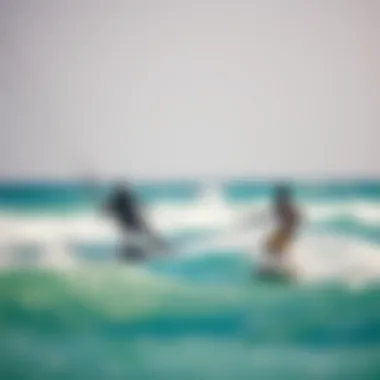

Diani Beach brims with activities, making it a paradise for adventure seekers. From parasailing to deep-sea fishing, each offering brings its own thrill. Kiteboarding is particularly prominent here, with lessons available for all skill levels. Beyond water sports, people can enjoy exploring nearby nature reserves or indulge in local cuisine at beachside restaurants. The variety of activities adds to the vibrant atmosphere, a definite thumbs up for those looking to pack their day with excitement.
Kikambala Beach
Scenic Views
Kikambala Beach is a visual treat, characterized by its stunning landscapes that juxtapose lush greenery against the azure sea. The beauty here is almost meditative, providing a serene backdrop that invites relaxation. One key feature is the rocky formations along the shore which add dimension to views, making it ideal for photography. The angles and colors shift from sunrise to sunset, enchanting visitors and creating memorable moments like focus of a dreamy getaway.
Local Culture
Embracing the local culture is central when visiting Kikambala Beach. The surrounding communities engage visitors with their rich heritage through folklore, traditional dances, and crafts. This cultural tapestry enhances the experience, providing insight into the daily lives of locals. Participating in local events can foster a deeper understanding of Kikambala’s vibrant spirit. Spotting traditional fishing boats and markets adds to the overall experience as well.
Water Sports Opportunities
Kikambala serves as a hub for various water sports, making it attractive for those keen on adrenaline. The beach's calm waters make it ideal for both novices and pros in jet skiing, paddleboarding, and more. What sets this beach apart is that instructors are easily accessible, enabling visitors to dive into new experiences without feeling overwhelmed. However, novices should be aware of the changing tides, as they can affect sports activities.
Watamu Beach
Marine Life
Watamu Beach stands out as an exceptional spot to engage with diverse marine life. The nearby Watamu National Marine Park boasts an impressive array of corals and fish species. Snorkeling and diving here reveal stunning underwater ecosystems, allowing a close look at vibrant sea life. This proximity to nature supports eco-friendly tourism and offers a special connection with the ocean for enthusiasts. Conservation efforts in the area are also a big focus, emphasizing responsible interactions with marine habitats.
Environmental Conservation
The commitment to environmental conservation is palpable at Watamu. Projects aimed at preserving the marine ecosystem are evident, with active initiatives to combat pollution and promote sustainable tourism. Visitors are encouraged to be conscious of their environmental footprint, which reinforces the importance of keeping these natural wonders for future generations. Engaging with local conservation groups offers unique insights and encourages participation—a fulfilling way to connect with the locale.
Kiteboarding Spots
Kiteboarding at Watamu is fabulous, particularly due to consistent winds and ideal water conditions. The area features dedicated zones with less traffic, allowing kiteboarders to practice freely. The scenery while riding—flying over colored waters with dolphins in the distance—is second to none. Pros and amateurs alike flock to these spots, making it a vibrant community. However, it’s wise to check forecast conditions because variability is common.
Malindi Beach
Historical Sites
Rich in history, Malindi Beach offers visitors a journey through time with its various historical sites. Landmarks like the Malindi Museum and the ancient Swahili ruins recount stories of trade and cultural exchanges. These sites serve not just as points of interest but as educational hubs for those keen on learning about Kenya’s storied past. They illustrate the melding of cultures that has shaped the coastal region, enhancing the appeal of Malindi as a historical destination.
Local Cuisine
Exploring local cuisine adds another layer to the Malindi experience—seafood reigns supreme here. Fresh catch from the ocean is a staple on many menus, giving visitors the opportunity to indulge in mouthwatering dishes. Sampling local flavors in beachside eateries creates an authentic culinary adventure. Dining under the stars with seaside sounds provides a memorable atmosphere which pairs well with spectacular sunsets, turning dinner into an event.
Relaxation Options
For relaxation, Malindi Beach is unbeatable. Its calm ambiance invites unwinding, whether lounging under a palm tree or enjoying a spa treatment. There are plenty of spots that cater to a tranquil atmosphere, allowing visitors to recharge. One significant advantage is the availability of wellness retreats nearby, where one can undergo holistic therapies. However, those seeking an active nightlife might find Malindi quieter than other beach destinations.
Lamu Island
Cultural Heritage
Lamu Island shines when it comes to cultural heritage. It is a UNESCO World Heritage site known for its rich Swahili architecture and traditions. Walking through its narrow streets feels like stepping back in history, where donkeys replace cars and music fills the air. The island’s festivals, showcasing traditional dance and crafts, create an enchanting atmosphere, inviting visitors to immerse in the local culture. This cultural richness serves as a significant draw, attracting those who cherish authentic experiences.
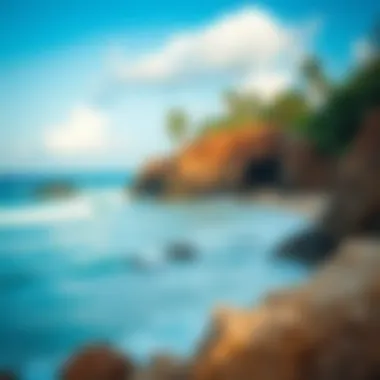

Beaches and Charms
Lamu is blessed with some of the coast's finest beaches, each with its charm. The soft sands and gentle currents offer a picturesque escape from the hustle of everyday life. Each beach can be explored at leisure, revealing hidden coves and serene spots perfect for sunbathing. These tranquil settings invite reflection, making Lamu a favored choice for those seeking to unplug and unwind. Visitors often comment on the unique peacefulness found nowhere else along the coast.
Activities for Tourists
Lamu also caters to the adventurous spirit with many activities for tourists. Water sports like kayaking and sailing complement the laid-back beach vibe. Additionally, exploring nearby islands on traditional dhows can provide a unique view of the coast. Cultural excursions, such as visiting local artisans or markets, offer enriching experiences that connect visitors with the community. Nevertheless, the limited nightlife can deter those looking for bustling evenings.
The Environmental Impact of Tourism
Tourism plays a pivotal role in shaping the environmental landscape of Kenya’s exquisite beaches. While it brings economic growth and opportunities to local communities, the effects on coastal ecosystems are significant and carry long-lasting consequences. This section delves into the intricate balance between tourism and environmental degradation, offering a lens through which we can understand both the challenges and benefits of visitor engagement with these delicate ecosystems.
Coastal Ecosystems
Kenya's coastline is rich with diverse coastal ecosystems, such as coral reefs, mangroves, and estuaries. These areas not only serve as habitats for myriad marine species but also provide essential services to coastal communities. For example, coral reefs act as natural barriers against coastal erosion, protecting beaches and the mangroves that thrive nearby. Unfortunately, increased tourism can disrupt these critical habitats.
Tourists inadvertently contribute to the wear and tear of these environments through activities such as snorkeling, boat riding, and littering. Moreover, the construction of resorts and other infrastructure often leads to loss of natural landscape and pollutes local waters with runoff from buildings.
"The very beauty that attracts tourists can also be its downfall if not managed responsibly."
In essence, coastal ecosystems are not just picturesque backdrops for leisure; they represent a fragile balance that needs careful stewardship. Without proper management, the delicate structures that harbor biodiversity can be compromised, leading to degraded environments that affect everything from fish stocks to beach accessibility.
Sustainable Practices
Sustainable practices in tourism are essential to mitigate negative impacts on the environment. Notably, these include responsible waste management, ecological restoration initiatives, and community engagement in conservation efforts. Tourists and operators alike can play a significant role in championing these practices.
- Waste Management: Implementing strict waste disposal guidelines can significantly reduce pollution in coastal areas. For instance, ensuring that plastic waste is minimized through clean-up initiatives can make a considerable difference. Visitors may be encouraged to bring biodegradable items or use refillable containers instead of single-use plastics.
- Conservation Programs: Many local organizations, such as the Kenya Marine and Fisheries Research Institute, engage in efforts to restore damaged reefs and mangroves. Tourists can participate, gaining deeper empathy for these ecosystems while directly aiding in their preservation.
- Eco-Tourism Initiatives: Some beach resorts adopt eco-friendly measures, such as solar energy and rainwater harvesting. Travelers opting for these accommodations can support sustainable tourism, as they are more likely to experience lesser environmental impacts.
Promoting such sustainable practices is imperative not just for the biodiversity of Kenya's coastal ecosystems but also for the longevity of the tourism sector itself. Keeping the coastal beauty intact benefits all parties involved, highlighting how a collective responsibility can create a win-win scenario.
By understanding and advocating for sustainable practices, both tourists and industry stakeholders can contribute meaningfully to the preservation of Kenya's breathtaking beaches and their surrounding ecosystems.
Kiteboarding in Kenya
Kiteboarding stands as one of the most exhilarating activities along Kenya's pristine coastline. The thrill of gliding across crystal-clear waters, paired with the steady winds, makes this sport a magnetic draw for both enthusiasts and novices. In this framework of our exploration, we underscore the pivotal role that kiteboarding plays, showcasing not only its recreational merits but also its contribution to local tourism and community engagement. By engaging with the local kiteboarding scene, visitors can gain deeper insights into Kenya's unique coastal environment while fostering economic benefits for local schools and instructors.
Best Conditions and Seasons
To truly appreciate kiteboarding in Kenya, one must consider the best conditions and seasons that pave the way for a remarkable experience. Typically, the wind patterns peak between June and September, during the southeast monsoon. This period, often referred to as the kiting season, sees consistent winds ranging from 15 to 25 knots, ideal for both intermediate and advanced riders who crave adrenaline.
It's essential to be mindful of the local weather patterns throughout the year, as kiteboarding off-peak can still yield rewarding moments for beginners wanting to learn the ropes. The warmer months, primarily from December to February, provide calmer waters, making this period suitable for introductory lessons, where ample time can be spent honing techniques in less turbulent conditions.
"Kiteboarding in Kenya isn't just a sport; it's a lifestyle that resonates with the rhythm of the wind and waves."
Local Kiteboarding Schools
Kenya boasts a vibrant network of kiteboarding schools, each equipped with experienced instructors ready to cater to various skill levels. Among the local heroes are Kite Surf Africa in Diani Beach and Watamu Kite in Watamu. These institutions offer structured lessons under the guidance of skilled coaches who emphasize safety and skill development.
Instructors often tailor their teaching styles to accommodate learners’ paces, helping them progress steadily. Additionally, these schools provide rental equipment, ensuring new kiteboarders don’t have to invest significantly before trying out this exciting sport. Here’s what to expect:
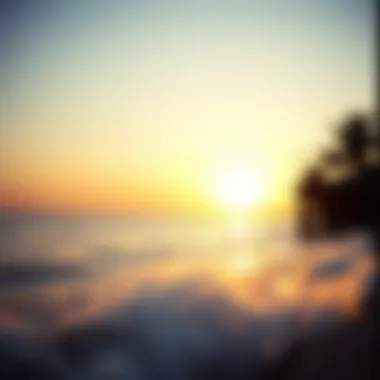

- Skill Assessment: Before jumping into lessons, instructors often conduct assessments to tailor learning plans.
- Safety Protocols: Emphasis on safety gears and protocols is a fundamental part of the curriculum.
- Community Events: Many schools host regular community events, offering a platform for both fun competitions and network opportunities.
Equipment Recommendations
Choosing the right equipment is crucial for an enjoyable kiteboarding experience. When getting started, certain elements should be prioritized to maximize safety and performance. Here’s a list of recommended gear:
- Kite: Depending on skill level, a larger kite (12-15m) is favorable for beginners in light winds, while more advanced riders may prefer a 7-9m for speedier winds.
- Board: A larger board tends to provide better stability for beginners. Consider at least a 136 cm board or longer to ease the learning curve.
- Harness: Opt for a comfortable waist harness that allows for optimal maneuverability.
- Safety Gear: Always wear a life jacket and helmet to prepare for unexpected falls or mishaps.
Investing in quality gear can significantly enhance the experience, leading to more comfortable and safer sessions on the water. Additionally, it's always a good idea to consult with local instructors about the best equipment for your specific conditions and skill level.
Through understanding these key aspects of kiteboarding in Kenya, enthusiasts and newcomers are set to find joy and excitement in navigating the arching waves and breezy shores. The possibilities for adventure are boundless.
Challenges Facing Kenyan Beaches
Kenya’s stunning beaches are not just about sun and surf; they face pressing challenges that could alter their beauty and accessibility. As the country continues to attract both local and international tourists, it’s paramount to address these hurdles to preserve the enchantment that each coastal location offers. Understanding these challenges is crucial, especially for stakeholders in tourism, including kiteboarders and instructors whose livelihoods depend on these ecosystems.
Climate Change Effects
Climate change is arguably the most significant threat to Kenya's beaches. Rising sea levels, resulting from global warming, cause coastal erosion that can lead to the disappearance of popular beach spots. For instance, at Diani Beach, frequent high tides have begun to wash away sections of the shoreline, causing concern among visitors and local businesses alike.
Moreover, with increasing global temperatures, weather patterns have changed, bringing about more intense storms. These storms can wreak havoc on beach infrastructure and local ecosystems. Coral reefs, vital to the marine life and the overall health of coastal waters, suffer from bleaching, which has knock-on effects for water sports activities like kiteboarding. Many times, eager kiteboarders find themselves without reliable spots for their sport due to deteriorated conditions.
In Kenya, the local government and communities have started to implement regrowth and conservation initiatives. From mangrove restoration to coastal barriers, these actions help mitigate the impacts of climate change by protecting shorelines.
Plastic Pollution
Another insidious issue plaguing Kenya’s beaches is plastic pollution. With the global surge in plastic consumption, Kenya isn't spared from the burden that comes with it. Beaches like Malindi and Watamu face challenges with littering, which threatens both marine life and the experience of beach-goers.
The impact on marine ecosystems is profound. Turtles, for instance, often mistake plastic bags for jellyfish, leading to fatal consequences. This not only endangers wildlife but also diminishes the allure for water sports and tourism. The sight of a pristine beach lined with trash is an immediate turn-off for visitors, and could dissuade potential kiteboarders from making the journey if they perceive a lack of care or maintenance in the area.
As a proactive measure, some coastal communities have begun hosting beach clean-up drives to combat this. Educational initiatives aimed at raising awareness about the repercussions of plastic waste are also being rolled out, encouraging tourists and locals alike to take part in preserving their natural surroundings.
"If we don’t take care of our beaches, what are we leaving for the next generation? Our responsibility goes beyond our pleasure; it includes safeguarding our environment."
End and Recommendations
Navigating through the coastal delights of Kenya reveals the beauty and complexity of its beaches. This section aims to underline the importance of embracing not just the natural splendor but also the responsibility that comes with it. Focusing on preservation and promoting responsible tourism practices ensures that these stunning locations remain a sanctuary for both locals and visitors alike. Consider this your guide for not just enjoying the beaches but also being part of their ongoing story.
Preservation of Natural Beauty
One cannot deny the breathtaking allure of Kenya's beaches. Diani, Watamu, and Malindi offer more than picturesque views; they contain unique ecosystems. Protecting such environments must be a priority. Various stakeholders, ranging from government bodies to local communities, have crucial roles in maintaining the health of these areas.
- Educate the Community: Local populations can significantly influence preservation efforts. When they understand the value of biodiversity, it fosters respect and care for their surroundings.
- Conservation Programs: Participate in or support programs that focus on rehabilitating affected areas. For instance, programs that rehabilitate mangroves and coral reefs are essential as they help in maintaining both marine life and coastal protection.
- Responsible Infrastructure Development: It is vital that any growth in tourism infrastructure respects and integrates into the environment rather than disrupts it. Well-planned development can help protect coastlines and ensure that natural resources are not exhausted.
The saying "We do not inherit the earth from our ancestors; we borrow it from our children" captures the essence of environmental stewardship. By being proactive, we can pass the beauty of Kenya’s beaches to future generations.
Encouraging Responsible Tourism
Tourism, while vital for the local economy, can leave heavy footprints if not managed wisely. Encouraging responsible tourism is key to preserving the coastal wonders while ensuring that tourists have an enriching experience.
- Awareness Campaigns: Visitors should be educated about local customs and environmental practices. Knowing how to respect both the culture and ecosystem can lead to a harmonious travel experience.
- Eco-friendly Activities: Select tours and activities that prioritize sustainability. Water sports, such as kiteboarding, can be enjoyed without harming the environment if conducted through responsible operators that follow ecological guidelines.
- Support Local Businesses: Rather than sticking with international chains, seek out local artisans and vendors. This not only enhances the experience but also bolsters the local economy, creating a win-win scenario.
Responsible tourism isn't just a trend; it's a fundamental principle that will dictate the future of coastal areas in Kenya. As the world observes more travelers flocking to popular spots, being conscious of their impact is not just a recommendation; it's a necessity.
"We do not travel to escape life, but for life not to escape us." This truth underpins the importance of making every trip meaningful, respectful, and enriching for both the visitor and the host.


